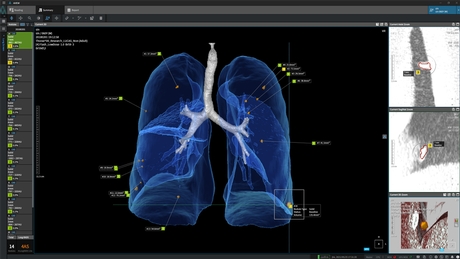
Jeudy
Radiologists may more accurately find and assess lung nodules with assistance from AI, according to the authors of a scientific poster presented on Thursday by Jean Jeudy Jr., MD, professor of diagnostic radiology and nuclear medicine, and vice chair of clinical informatics at the University of Maryland School of Medicine.
"Lung cancer remains the leading cause of mortality worldwide—more than breast, colorectal and prostate cancer combined," Dr. Jeudy said. "Early detection of lung cancer with low-dose CT lung cancer screening allows for more effective treatment."
Because indications for screening eligibility continue to expand, he said, this increase in volume foreshadows an impact on radiologists' capacity and ability to keep up with the workload. "AI can potentially increase workload efficiency while also allowing increased diagnostic accuracy," he said.
Evaluating the Effect of AI Assistance
Dr. Jeudy and colleagues performed a multicenter retrospective reader study focused on the detection and measurement of lung nodules. There were 151 chest CTs, 48 of which had at least one lung nodule and 103 of which were negative.

AI-assisted summary view of pulmonary nodules detected, which was presented to the reader. The summary demonstrates the distribution and size of nodules detected with AI assistance. Image courtesy of Jean Jeudy Jr., MD
Ten board-certified radiologists interpreted the test cases in blinded fashion in two reading sessions: first without using AI assistance, and second with AI assistance after a four-week washout period. To use AI assistance, the radiologists used an FDA-cleared image viewer with or without a fully automated deep learning AI model for lung nodule detection and measurement.
The researchers then assessed diagnostic performance by comparing AI-assisted and unassisted reading sessions by evaluating accuracy, as measured by area under the jackknife adjusted free-response ROC [AFROC] curve. They also measured sensitivity, specificity and false positive rates. They compared reading times using mixed-effect Gaussian regression with a fixed effect for AI assistance and with clustering at the reading level.
Increased Accuracy, Efficiency with AI
According to Dr. Jeudy, the radiologists' accuracy improved from AUFROC 0.73 for unassisted reads to 0.92 for AI-assisted reads (p<0.001). In addition, sensitivity was improved, going from 0.68 to 0.91 (p<0.001), while false positives decreased from 0.48 to 0.28 (p=0.030). AI also helped the radiologists complete their reads more quickly, with mean read time going from 336 seconds to 100 seconds (p<0.001).
"AI-assisted lung nodule detection significantly improved radiologist accuracy and efficiency of detection and measurement more than three-fold, outperforming current manual methods of lung nodule detection and measurement," Dr. Jeudy said. This becomes important for lung cancer screening and evaluation of incidental lung nodules and metastatic disease, he noted.
Evidence-based guidelines regarding appropriate nodule classification and management continue to evolve, including the American College of Radiology Lung Imaging Reporting and Data System (Lung-RADS), which was updated in November 2022, Dr. Jeudy noted.
"With the increasing complexity of the guidelines, AI assistance tools can improve adherence to appropriate categorizations and management strategies," he said.
"Continued investigation is needed to evaluate the impact of AI on lung cancer screening and nodule detection," Dr. Jeudy concluded. "The potential downstream benefits may include improved radiologist efficiency, better patient outcomes—and, possibly, reduced health care costs—by improving disease prevention."
Access the presentation, "Radiologist Performance With and Without AI Assistance for the Detection of Lung nodules on Chest CT," (R6-SSCH10-3) on demand at Meeting.RSNA.org.

